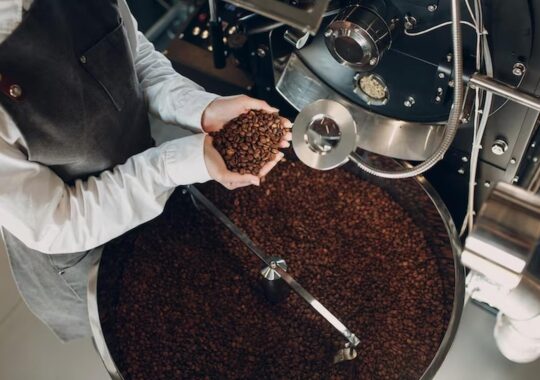Ever wonder how your favourite bean-to-cup coffee machine makes the perfect brew each morning? From grinding the beans to steaming the milk, these machines are marvels of modern technology. Let’s explore the science and process behind these coffee makers and why they’re a must-have for coffee lovers.
If you’re a coffee lover, you understand the importance of a fresh, aromatic brew to start your day. But have you ever stopped to think about what happens inside your bean-to-cup coffee machine? This engineering marvel performs multiple tasks to bring you that perfect cup of coffee, blending technology and tradition.
Bean-to-cup coffee machines have gained popularity due to their convenience, quality, and ability to replicate the barista experience at home. Every step, from the ground of the beans to the coffee, is automated to guarantee uniformity and taste. In this article, we’ll explore the inner workings of these machines, breaking down the entire process to show how science and engineering combine to deliver your ideal cup of coffee.
The Magic Starts with Fresh Beans: Grinding Process
The first step in any great coffee is the grind. Bean to cup coffee machines start by grinding whole beans just before brewing. Freshly ground beans are crucial for retaining the natural oils and flavours that give them their rich taste. But why is grinding necessary, and how does it affect your brew?
- Grind Consistency: The grind size impacts the extraction process. Finer grinds work best for espresso, while coarser grinds are better for drip coffee. Bean-to-cup machines offer customisation to control the grind size, ensuring it matches your brewing preference.
- Preservation of Flavor: Pre-ground coffee loses its flavour and aroma faster due to exposure to air. By grinding on demand, these machines preserve the natural oils in coffee beans, providing a fresher taste with each cup.
- Grinding Mechanism: Many bean-to-cup machines use burr grinders, which are known for producing a consistent grind size compared to blade grinders. Burr grinders crush the beans between two abrasive surfaces, ensuring uniformity.
Water Temperature: The Key to Extraction
After grinding, the next crucial element is water. The temperature of the water directly influences the flavours of the coffee grounds. Bean-to-cup coffee machines are engineered to maintain the perfect temperature throughout brewing.
- Deal Temperature Range: For optimal coffee extraction, the water needs to be heated to between 195°F and 205°F (90°C to 96°C). This temperature range ensures the coffee grounds release their soluble compounds without burning.
- Thermoblock Technology: Most modern bean-to-cup machines use a Thermoblock system to heat the water instantly. This technology ensures that each shot of espresso or cup of coffee gets water at the right temperature without waiting for the machine to reheat.
- Consistency in Brewing: Unlike manual brewing methods, bean-to-cup machines control the temperature throughout the brewing cycle. It leads to better consistency in taste, as each cup is brewed under identical conditions.
The Extraction Process: Achieving the Perfect Brew
The heart of a bean-to-cup machine’s operation lies in the extraction process. It is where the magic happens, transforming ground coffee and hot water into a flavorful brew. But what exactly is happening during extraction?
- Coffee Extraction: Extraction refers to the process of soluble compounds in coffee grounds using water. The time that water stays in contact with the grounds, along with the water pressure, affects the strength and flavour of the coffee.
- Pressure Control: Bean-to-cup machines force water through the coffee grounds at a specific pressure. For espresso, this pressure is around 9 bars, which extracts a rich, concentrated shot.
- Brewing Methods: Many machines allow you to choose between different brewing methods, from espresso to lungo or americano, by adjusting water volume and pressure. It ensures that you can customise your experience based on your preference.
Milk Frothing and Steaming: Creating Lattes and Cappuccinos
A significant feature that sets bean-to-cup machines apart is their ability to froth and steam milk, making them ideal for creating lattes, cappuccinos, and other milk-based coffee drinks. But what is the science behind perfect frothy milk?
- Frothing vs. Steaming: Frothing introduces air into the milk, creating a light foam for cappuccinos, while steaming heats the milk for a smoother texture in lattes. Bean-to-cup machines often come with automated steam wands or milk frothers that make this making.
- Steam Pressure: Just like brewing coffee, the temperature and pressure of the steam affect the milk’s texture. The machine’s steam wand injects steam into the milk at high pressure, creating microfoam—tiny bubbles that give the milk a creamy consistency.
- Temperature Control: Ideal milk frothing requires the milk to be heated between 140°F and 160°F (60°C to 70°C). Too hot, and the milk will scald; too cold, and it won’t froth properly. Bean-to-cup machines often feature precise temperature controls to help you achieve the perfect foam every time.
Automatic Cleaning Systems: Maintaining Quality Over Time
A well-maintained machine is essential for consistently great coffee. Bean-to-cup machines come equipped with automatic cleaning systems that handle much of the maintenance for you, ensuring the inner components remain free of coffee residue and mineral buildup.
- Self-Cleaning Functions: Many machines have built-in cleaning programs that flush the coffee spout and brew unit after each use. It prevents old coffee grounds from affecting future flavours.
- Descaling: Over time, mineral deposits from water can build up inside the machine, particularly in the heating element. Bean-to-cup machines often prompt you when it’s time to descale, and some modes perform the descaling automatically.
- Hygiene in Milk Frothing: Machines with milk frothers or steam wands usually feature an automatic milk cleaning cycle, which ensures that urine is purged from the system after each use, which is crucial for hygiene and flavour.
Customisation and Personalisation: Crafting Your Perfect Cup
One of the significant benefits of bean-to-cup machines is their level of customisation. These machines allow you to personalise the grind size to match the strength of the coffee and the milk frothing. It’s like having a personal barista at home.
- Adjustable Settings: You can adjust settings such as coffee strength, water volume, and temperature. Whether you prefer a strong espresso or a mild latte, these machines give you the flexibility to fine-tune the brew to your liking.
- User Profiles: Some high-end machines allow you to save multiple user profiles. This feature is handy for households where each member has a different coffee preference. The machine will remember the settings for each person’s favorite brew.
- favouriter Double Shots: Most bean to cup coffee machines let you choose between single and double shots; some even offer dual spouts to make two cups simultaneously. This feature is perfect for busy mornings when you need your coffee quickly.
Conclusion
Bean-to-cup coffee machines combine cutting-edge technology with time-honoured traditions to deliver a superior coffee experience. From grinding fresh beans to controlling water temperature and frothing milk, these machines do it all—without compromising on quality. They offer the perfect balance of convenience and control, making them an ideal choice for coffee enthusiasts who value both flavour and understanding the science behind how bean-to-cup coffee machines work; you can appreciate the level of engineering that goes into each cup. These machines are designed to ensure every cup is as fresh and flavorful as possible, providing a café-quality experience in the comfort of your home.





